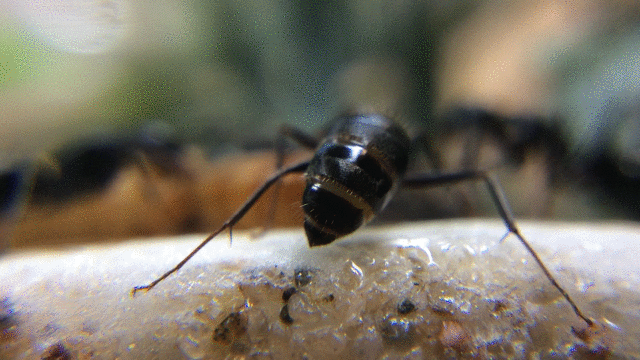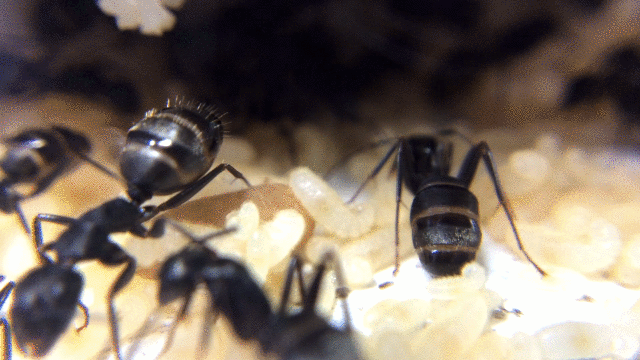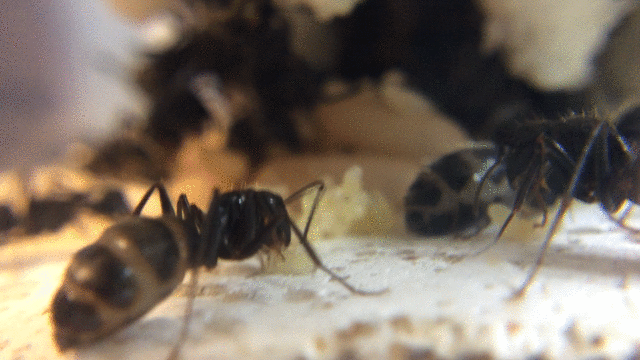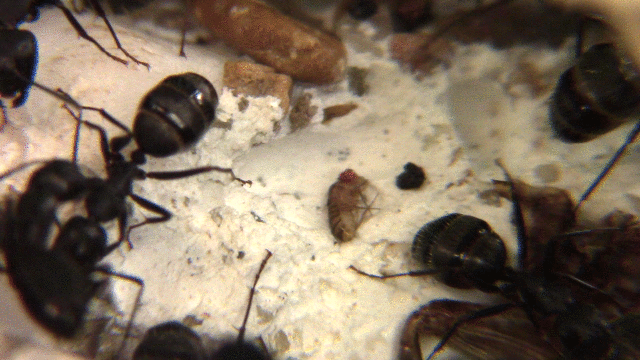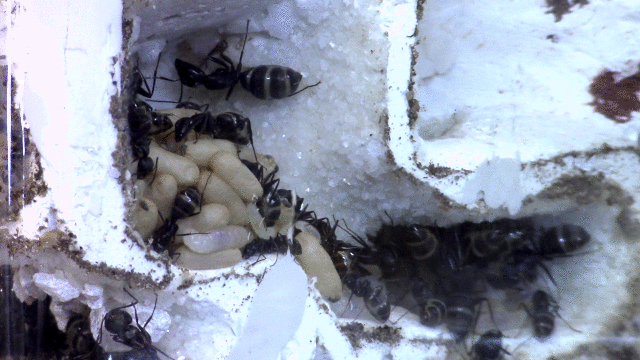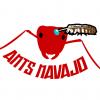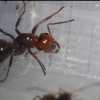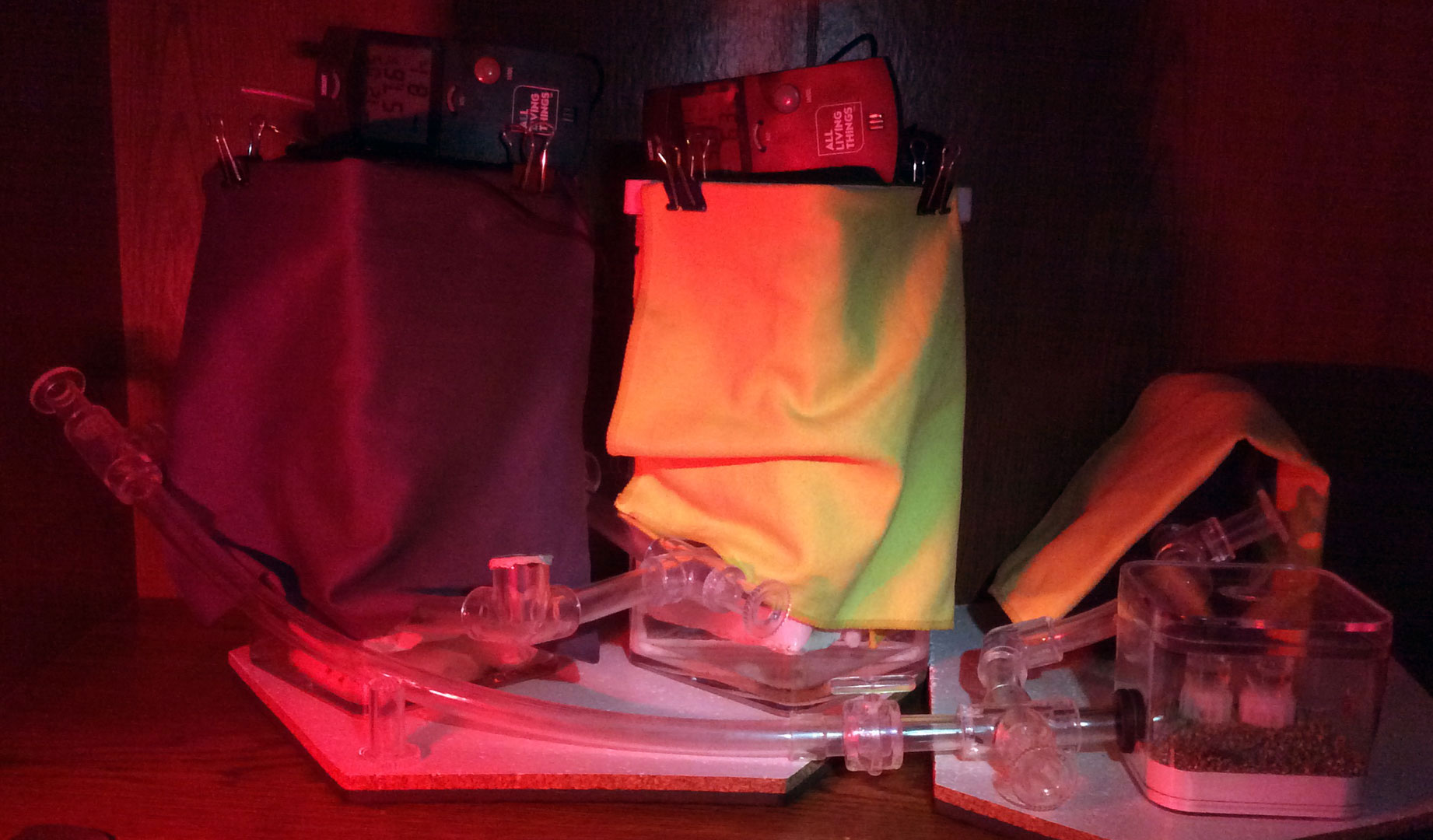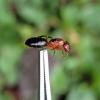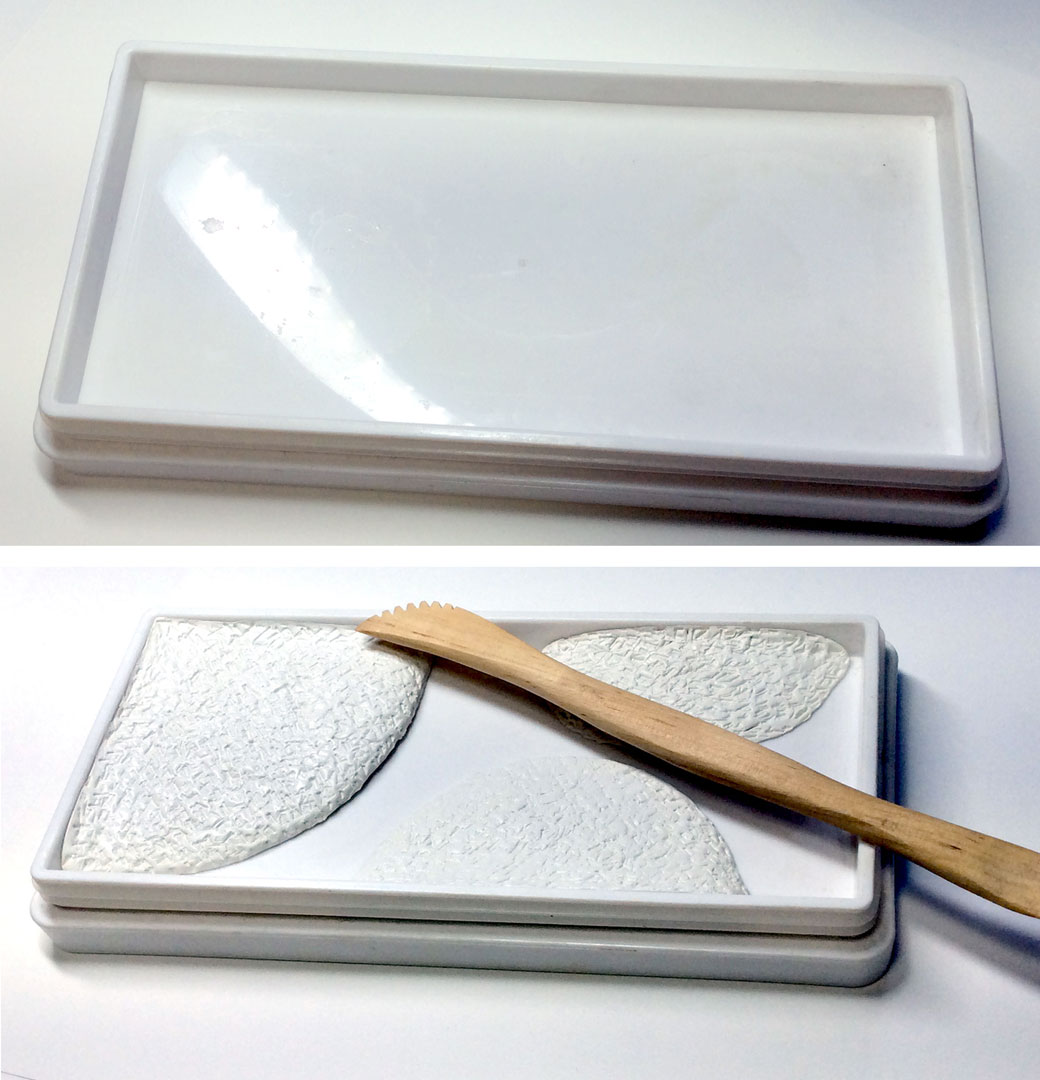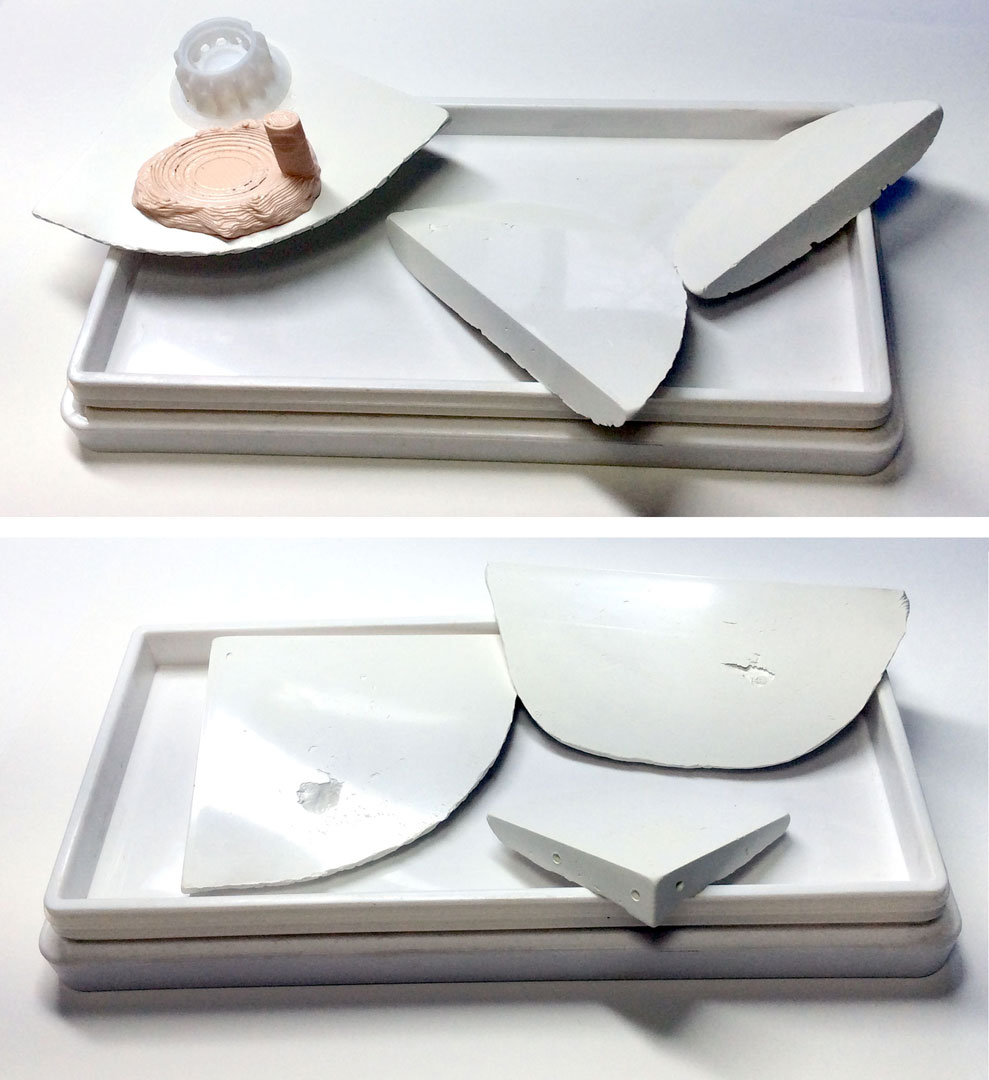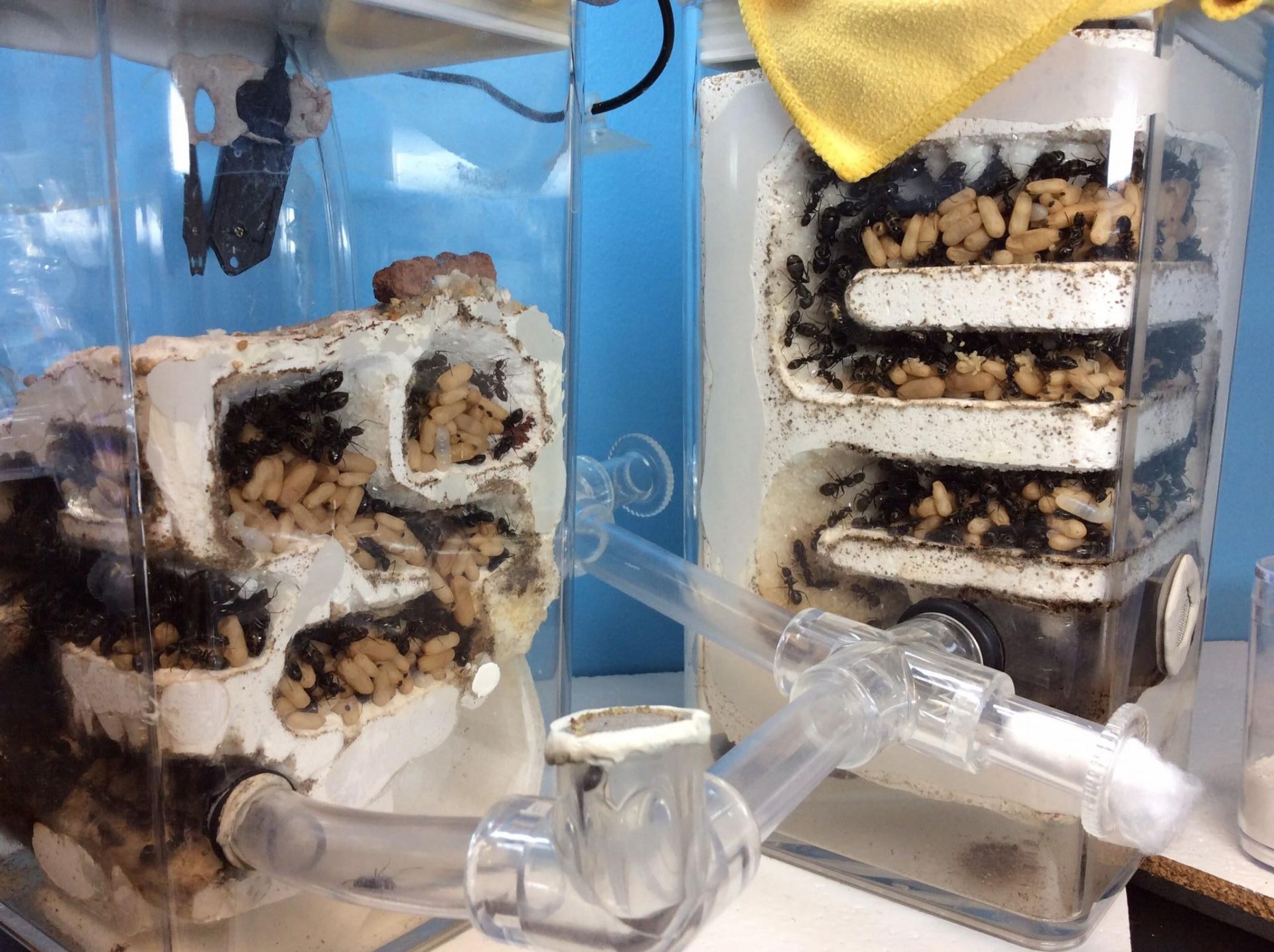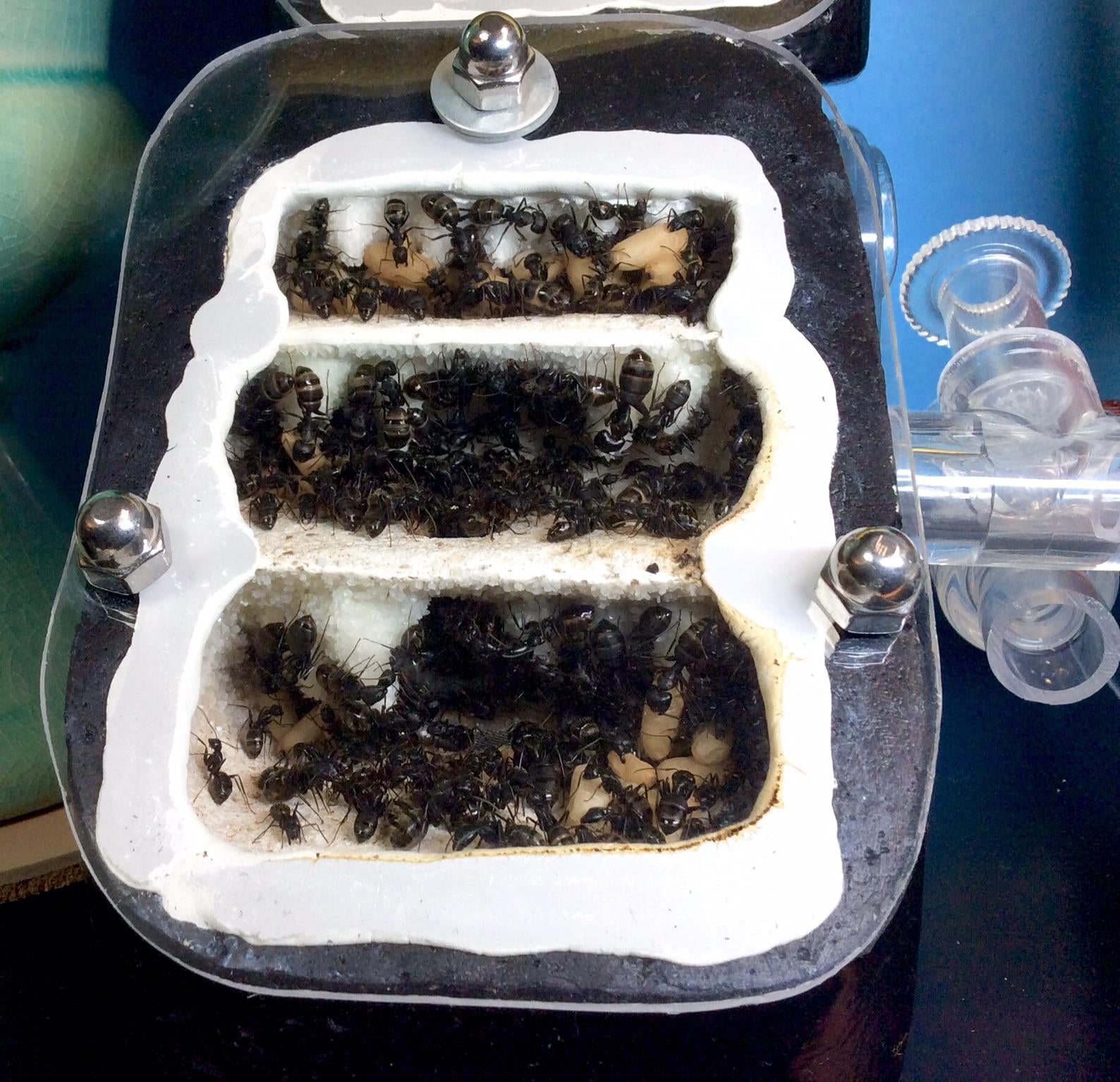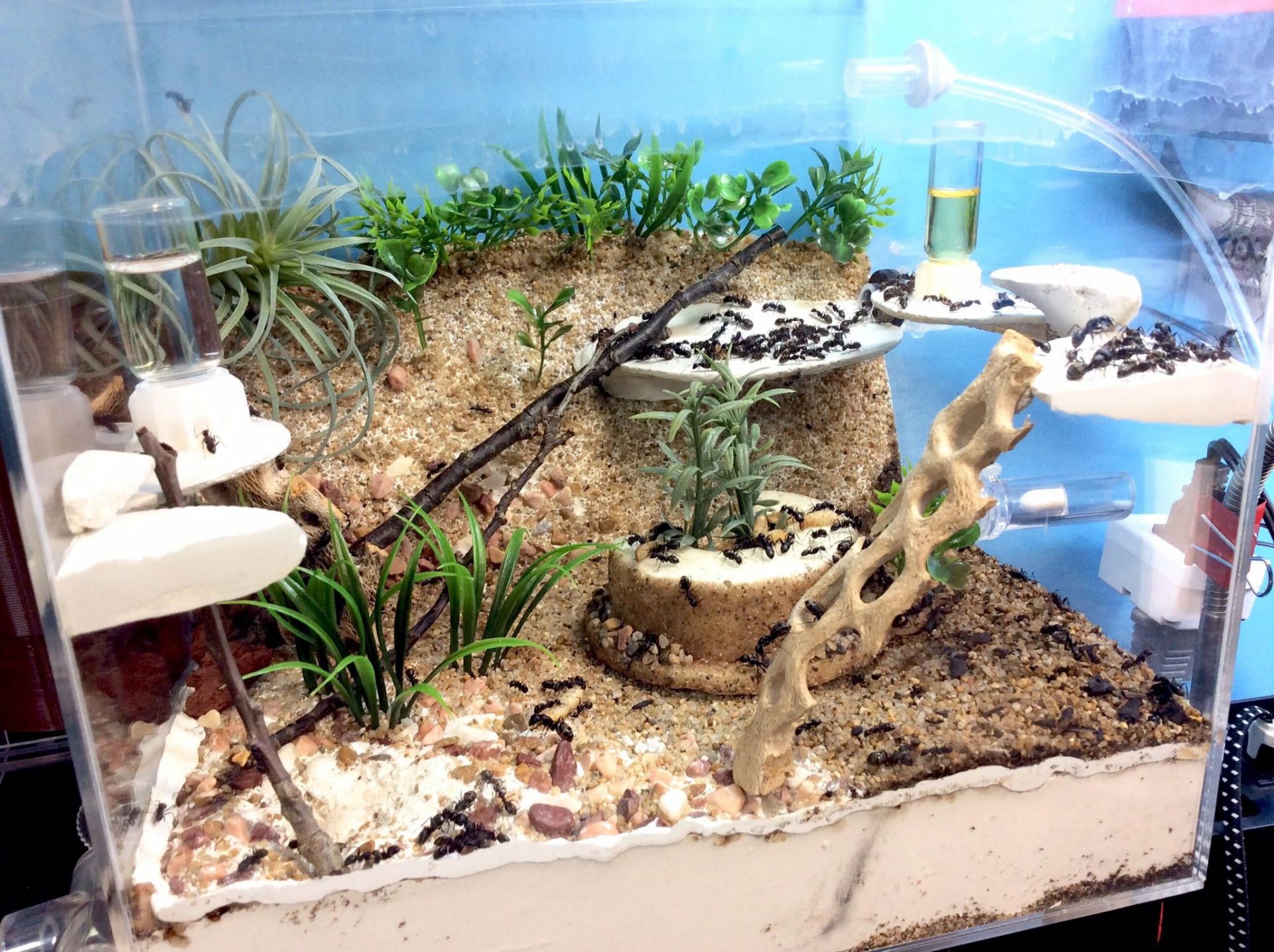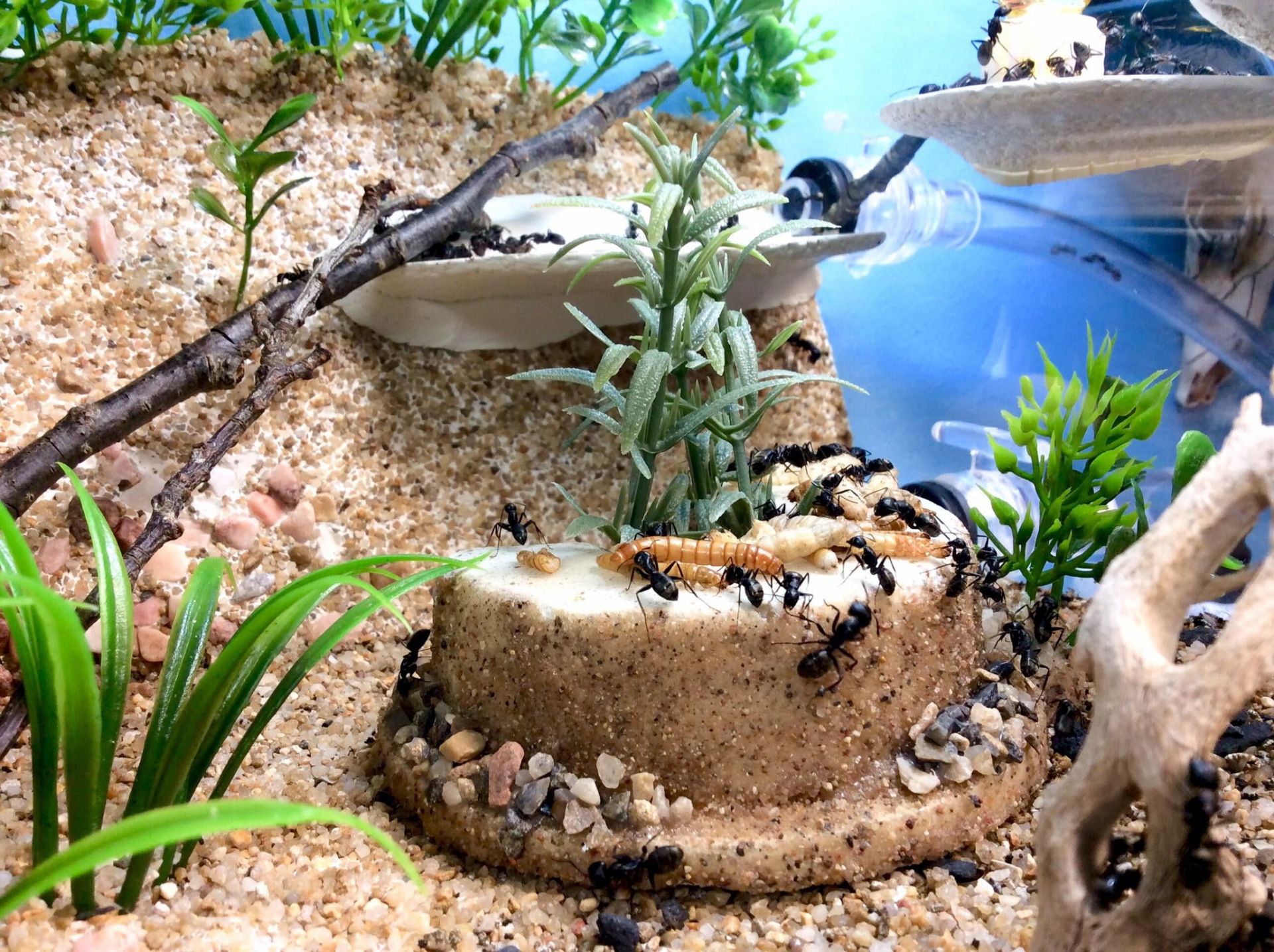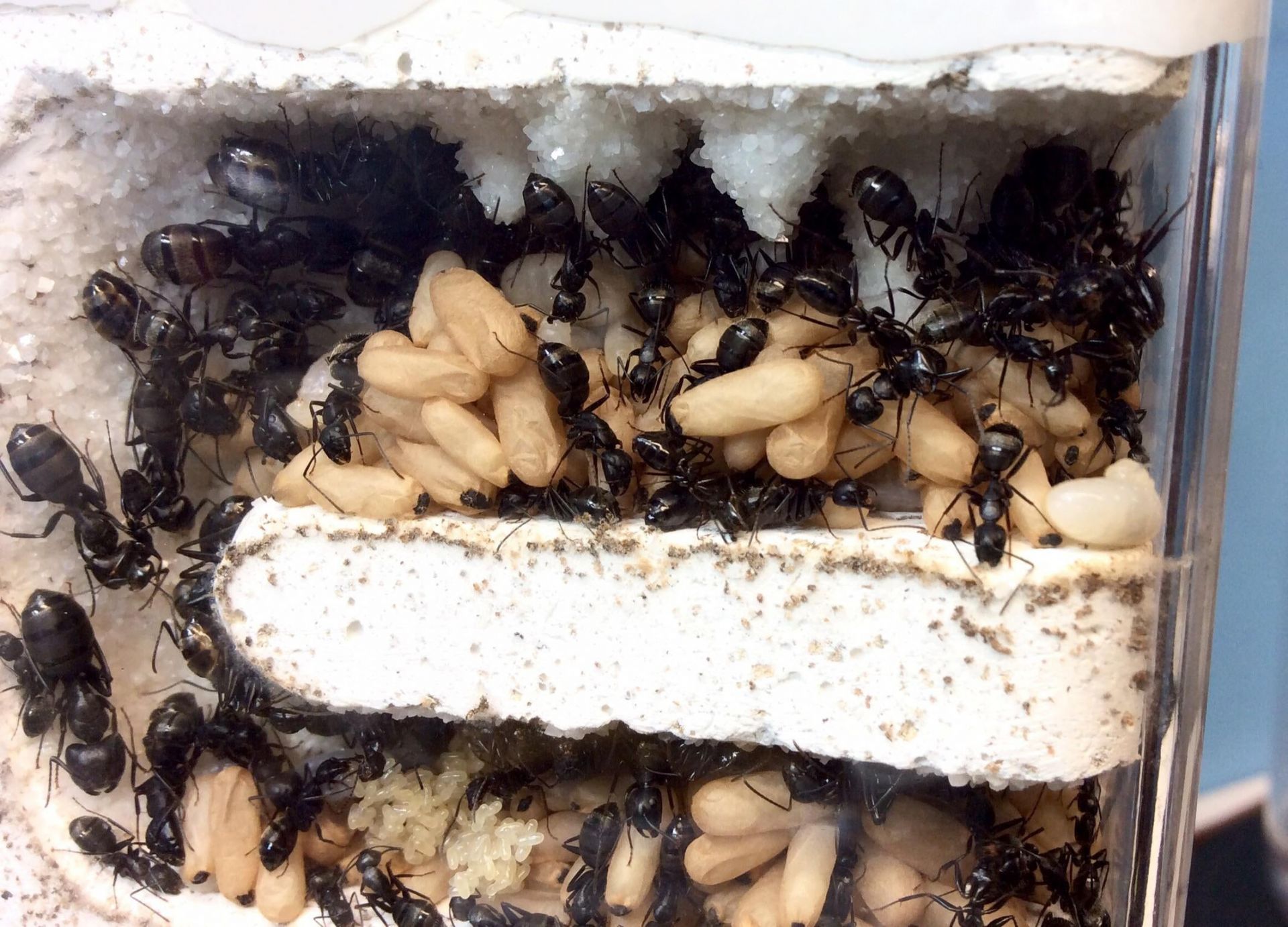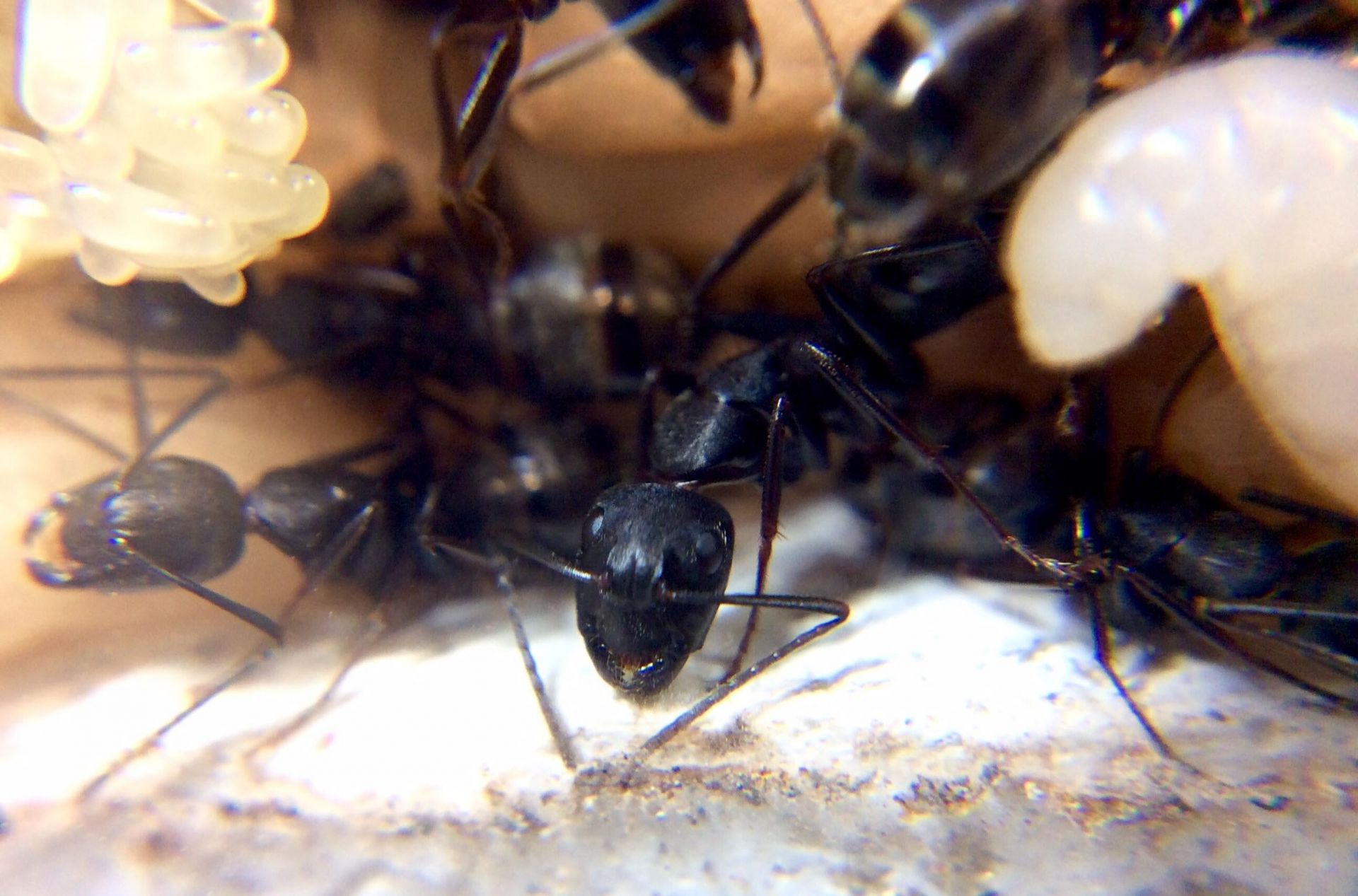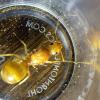Hello fellow formic folk! I know some of you were licking your mandibles for more updates so here we go!

I’ve been busy tending to my growing colonies while trying to capture footage this ant year that I’m finally going through and making gifs from what looks interesting. It’s a time consuming process but I like seeing ants in movement and the end result is that ya’ll get to see my journal come alive a bit along with a few pics thrown in the mix. Let me share some journal content like ants do trophallaxis, bit by bit!

Most of the gifs are time-lapsed, so they’ll look sped up but I tried to keep some in real-time. I’ll be focusing on my Camponotus pennsylvanicus colony and their food intake this year in this post.
Early in June, Queen Elizabeth’s colony was starting to fill out both DIY nest towers.

By the end of August, the colony was testing out the edges of the outworld and biting at the AC plugs I use to block their tubing that I knew they needed an expansion. I added one of the DIY nests I built, which I’ll share more about in the next post about colony growth.
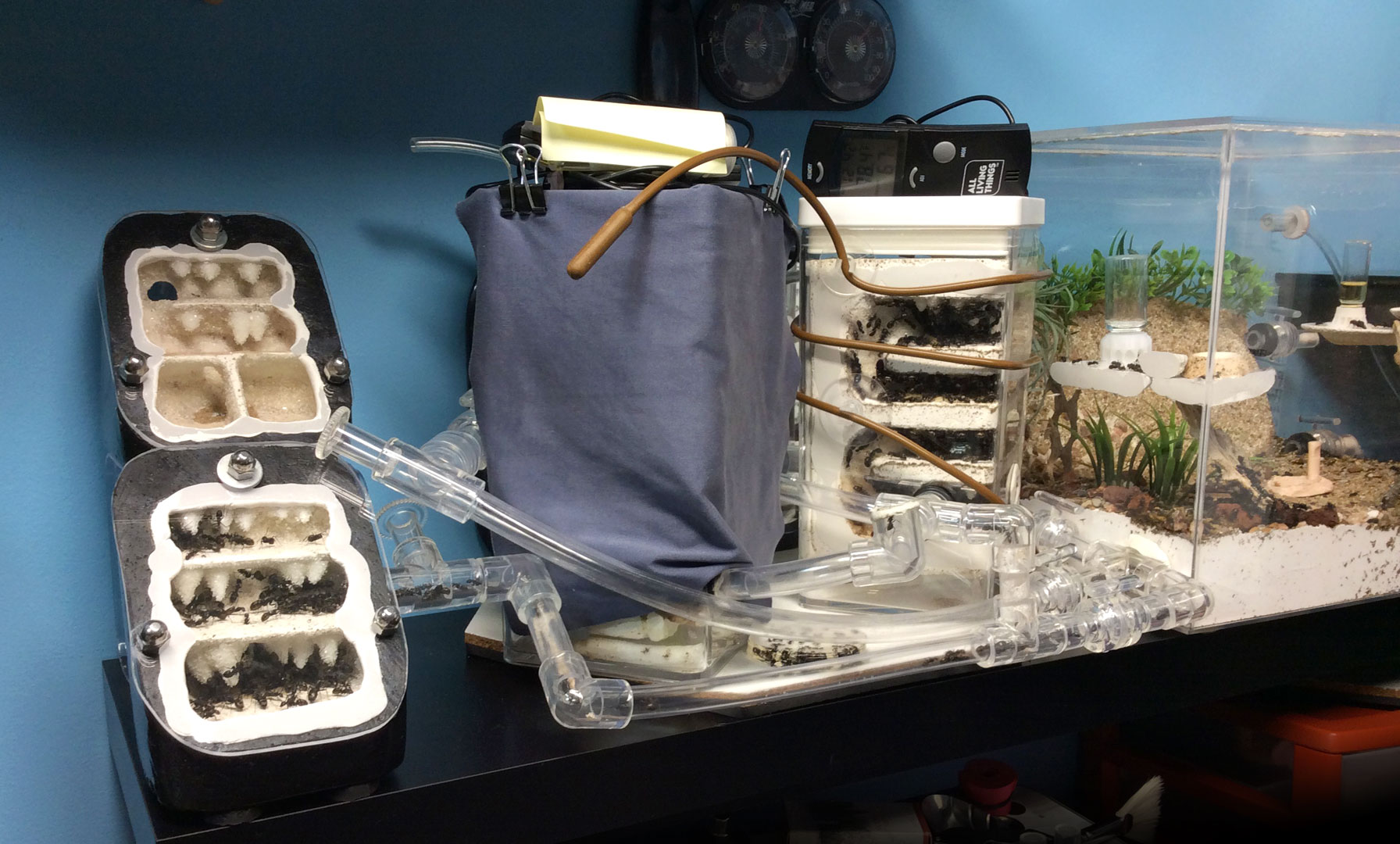
I’d also been testing out the hardscape decor I shared in previous posts. The extra surface area to explore seemed to keep the ants interested.
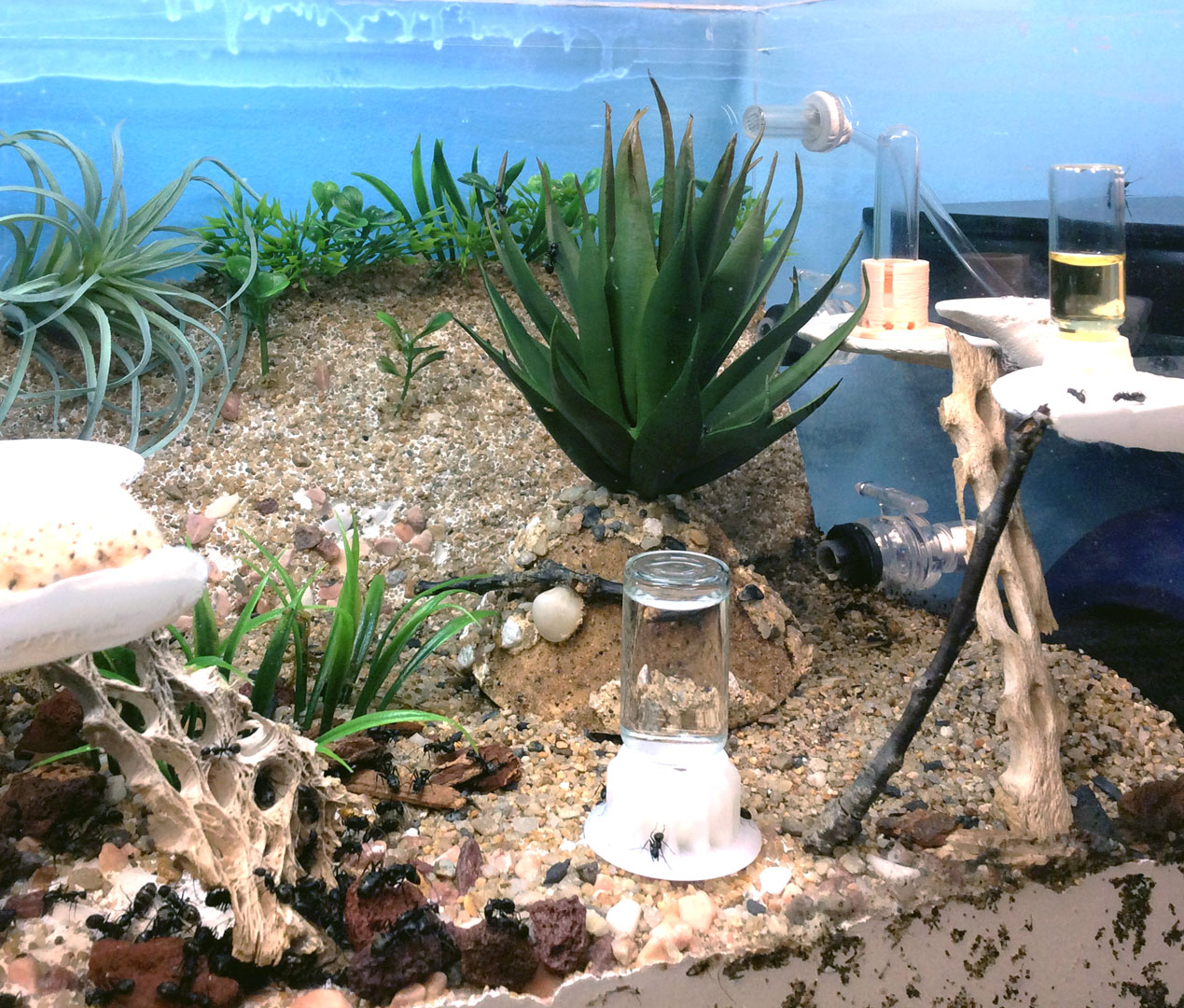

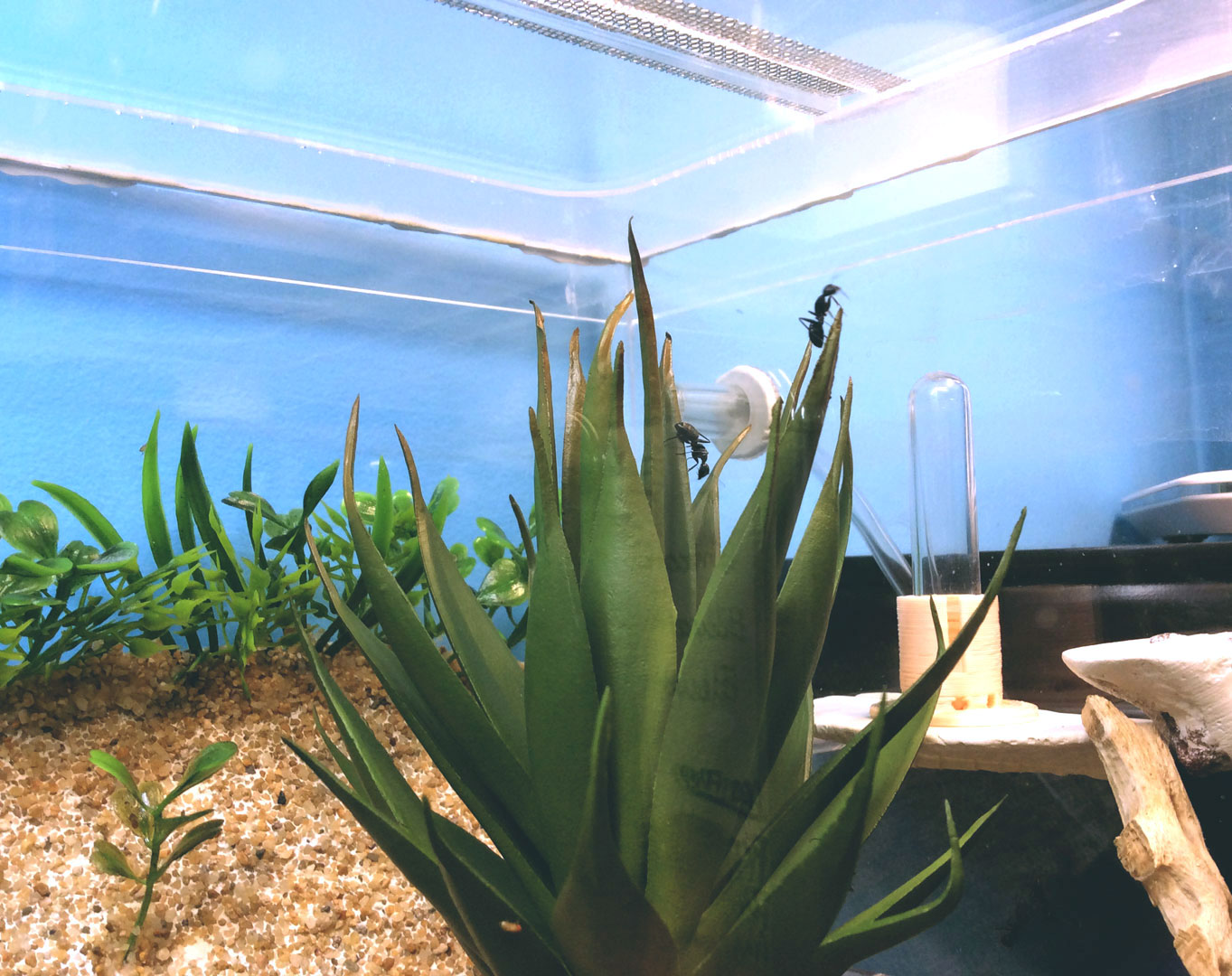

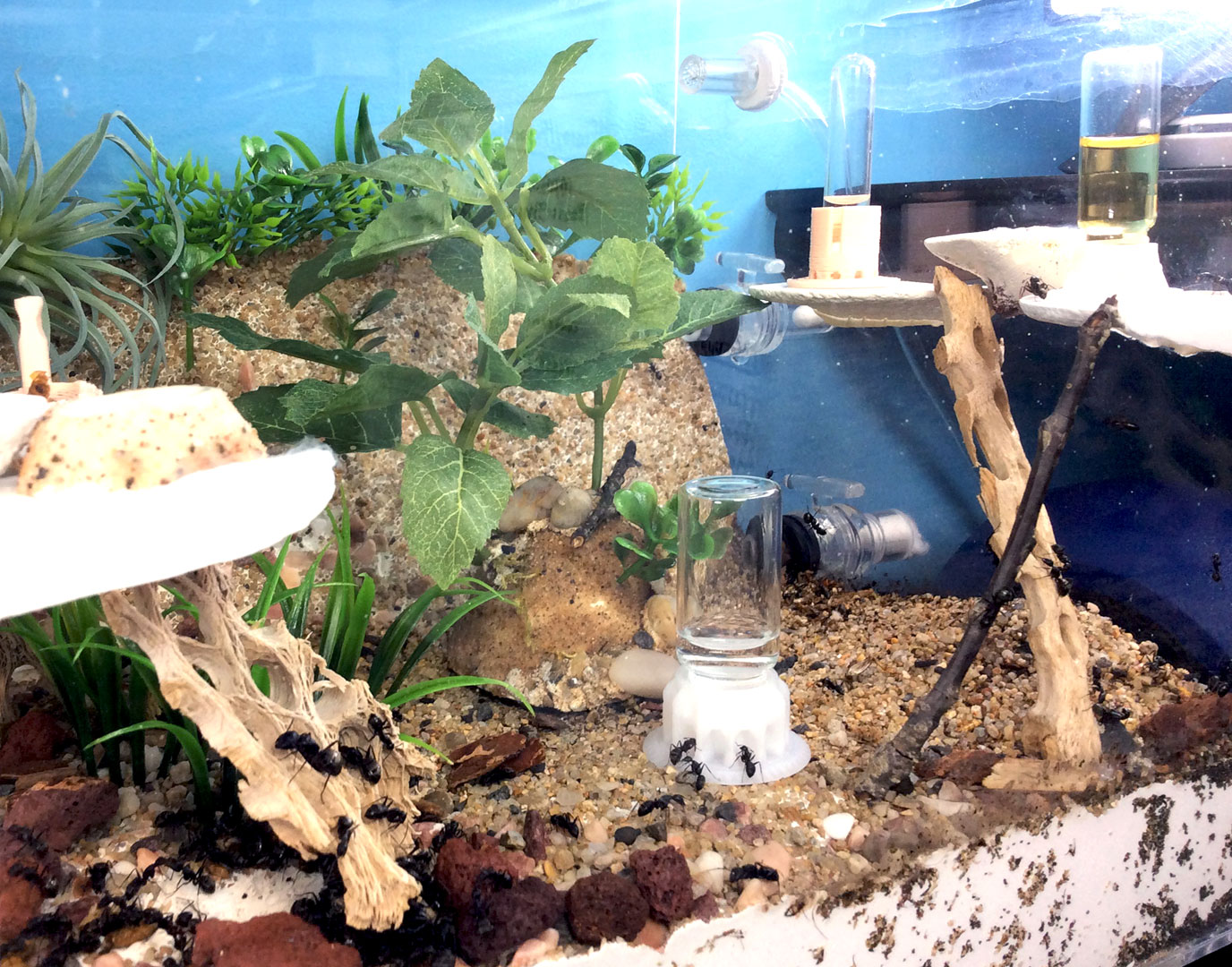

Time for a grooming break!

I cycled through the usual protein sources this year: crickets, mealworms and fruit flies with the occasional wax worms, bloodworm soup, meat/egg scraps or crane fly that unfortunately flew indoors.
I also had a false widow spider over the summer that was producing egg sacs that I was giving to my ants which worked out for awhile (this one was complicated for me because in Navajo culture spiders are important). She unfortunately lost a battle with a mealworm that knocked her dead and I decided to feed her to my colony in the end. She took down many mealworms and fruit flies in her day and laid about 7 or so egg sacs over several months, each one full of dozens of delicate eggs. The first time I handled the sacs was not easy, I popped out a few eggs in the enclosure that eventually hatched. I’ve got a male spider left behind but he doesn’t eat as much and probably will not last long while the other few either died off or were cannibalized. I got good at scooping out full spider sacs while keeping the eggs together because they’re really fragile and easily burst. They were like juicy melons to my ants, lol.
It was a different experience keeping and feeding a spider, maybe I’ll try again next year with a jumping spider or another false widow.

So that’s all to say that a variety of protein is best for a thriving ant colony. I even tried out some hemp seeds too but they didn’t seem too interested but will try again in the future.
Most antkeepers seem to suggest boiling your feeder insects to kill any mites or parasites before feeding but I wonder how many actually practice this process. I’ve tried it a few times using a portable induction cooktop with a small stainless steel cup and the ants still seemed interested in the food so the pros here maybe outweigh the cons of doing so. The ants seem to prefer the liquid in a fresh cricket though, which can congeal when cooked. I just try to inspect my feeder insects before feeding and haven’t had any issues yet.
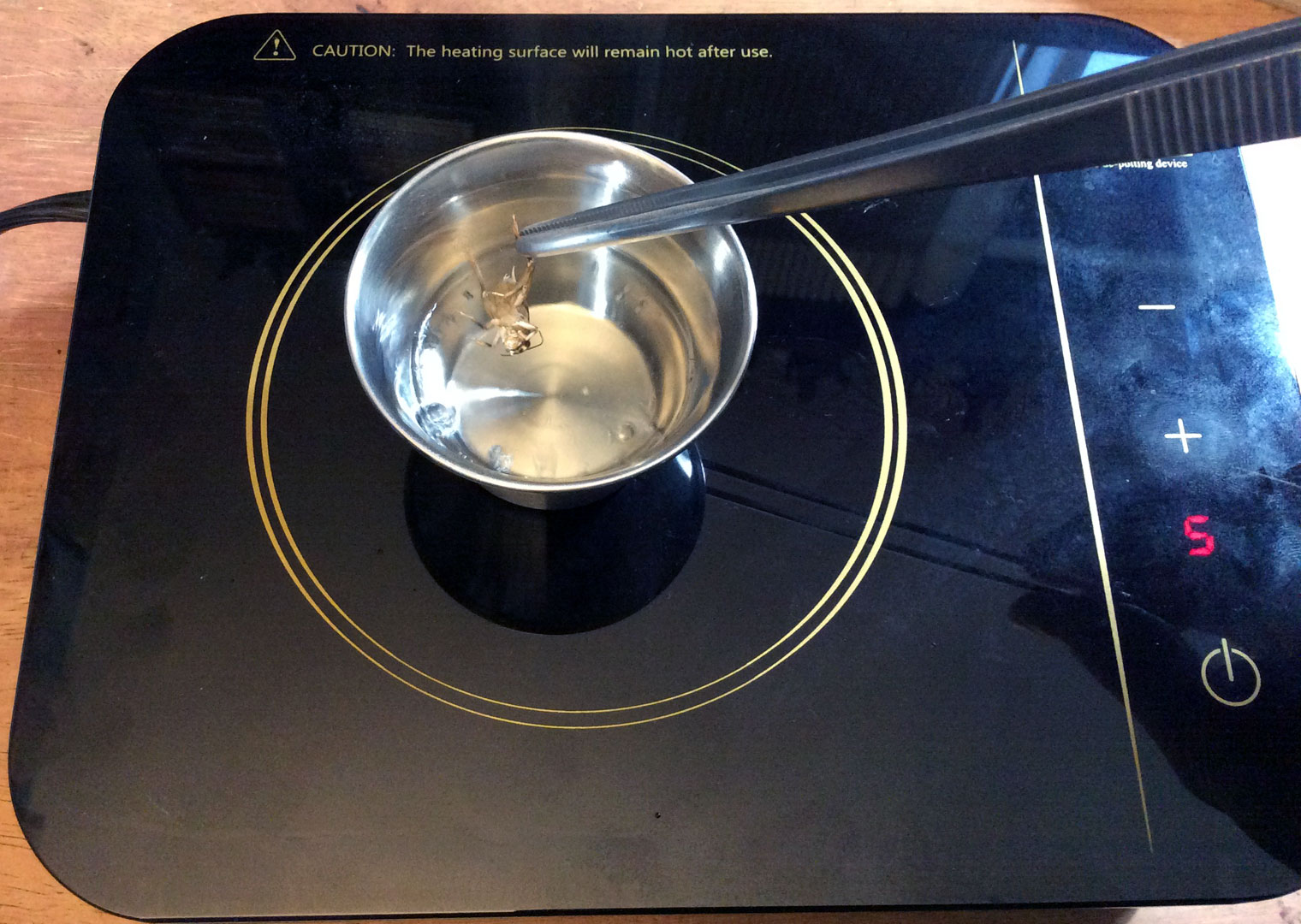
I somehow didn’t document much about how I handle crickets but they’re one of the staples I feed. I get my feeder bugs from a local Petsmart and the store is well maintained. I usually get the smaller bulk crickets so I could let them grow until they molt while gut-loading them for a few days using fresh veggies, hemp seeds, bird greens (mainly alfalfa) and Fluker’s Cricket Diet along with water crystals for hydration.

I have a plastic Target food container with a screened lid that I use to keep them enclosed while they grow, which has cut up cardboard fast food cup holders for hiding spaces, water and food dishes and some vermiculite flooring to absorb their waste. It holds about two dozen to thirty crickets but a few do end up dying that I pick out and feed off as soon as possible. With the ventilation and substate bottom, it doesn’t smell too bad. I just use a tiny amount of food, clear it out after a day and repeat for about a week or so.

While they’re nice and gut loaded, I try to feed them off fresh but I freeze most of them to use down the road. I use a small airtight container with some dry cous cous to keep the crickets from freeze damage and it has worked out so far although the smaller ones can still dry out. I freeze them for about half an hour initially in their enclosure, then I quickly pick them out and place back in the freezer in their storage container with dry cous cous. I have to be fast when I pull out a cricket because I don’t want to thaw out the rest when I do so. Constant thawing and freezing ends up with bad protein.
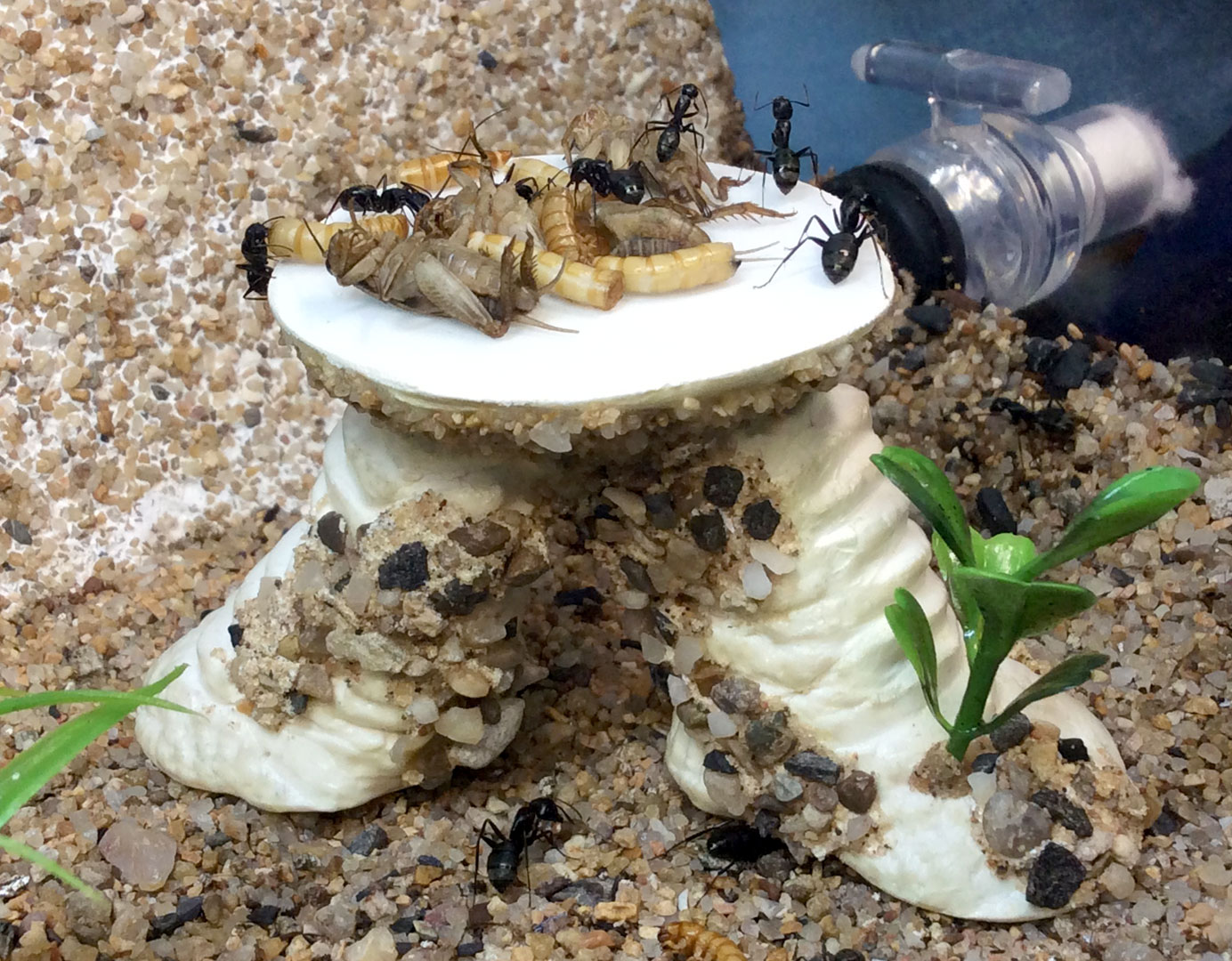
I’ve enjoyed observing my ants using feeders like the Ant-Shack ones above or the ones that I’ve made. I’m wondering if anybody would be interested in purchasing their own Boog feeding platforms? I’ve got some plans to make a batch of feeders that I might try to sell which I’m designing to fit with small outworlds. More updates in the future!

I hope you’re lapping up this nourishing antkeeping content!
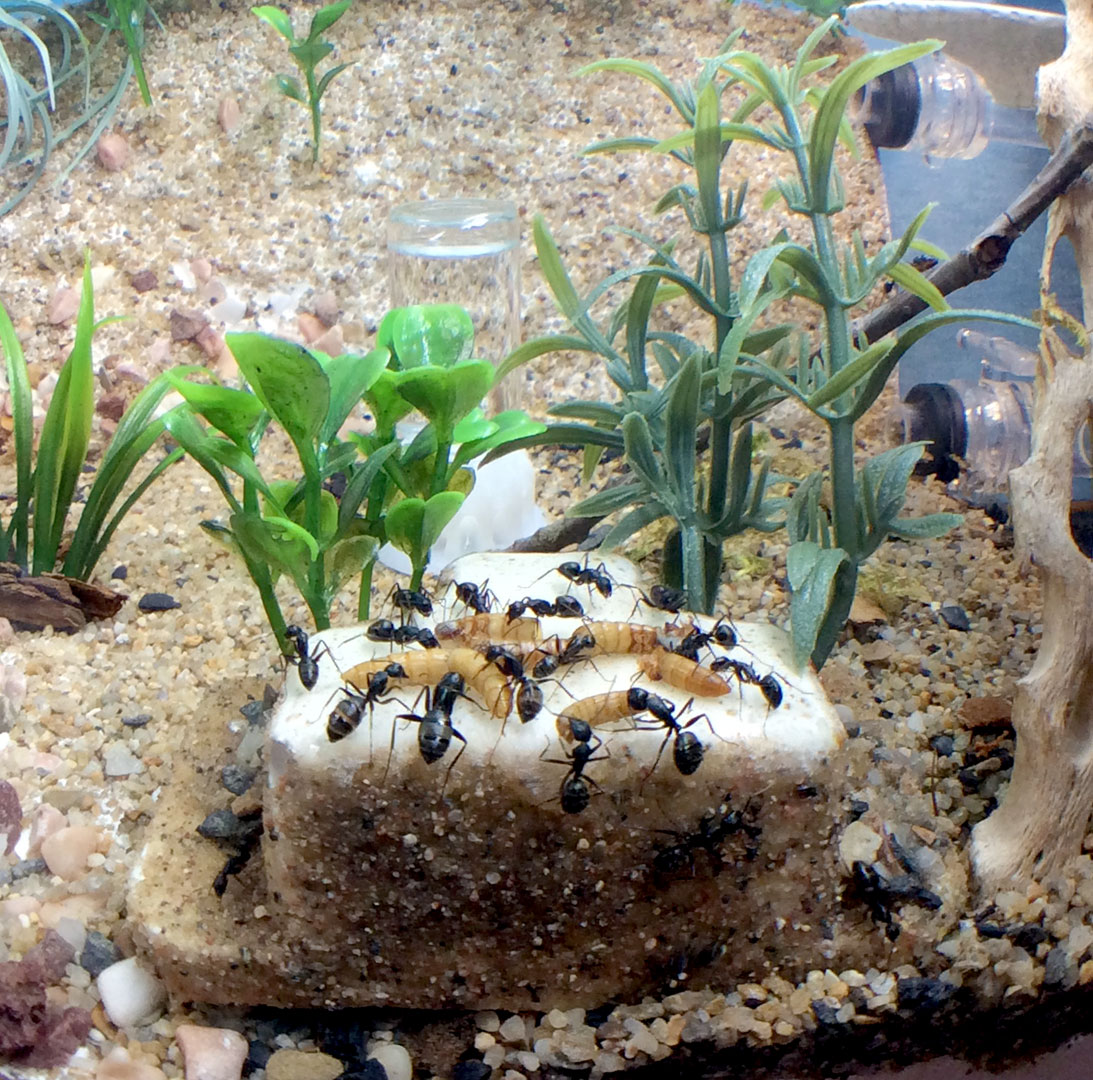
Now onto mealworms, another staple feeder I pick up from the pet store. I get a batch of 50 small/medium ones that I also like to feed veggie scraps to which supplements the food substrate they come in and provides hydration. However, I don’t freeze mealworms as their growth can be slowed down with refrigeration. I pull them out once a week to warm up and feed them for a couple of hours or overnight, then put them back into the fridge. I pick off the largest mealworms first to feed to my ants and sometimes get pupae to feed off too, depending on how well they’re fed. These are very similar to superworms but I like the smaller size of mealworms. I try to inspect them and their container often with a magnifying glass to spot any bad buggers. I threw one batch out because it looked like there was possible mites so I think inspection is a good idea.
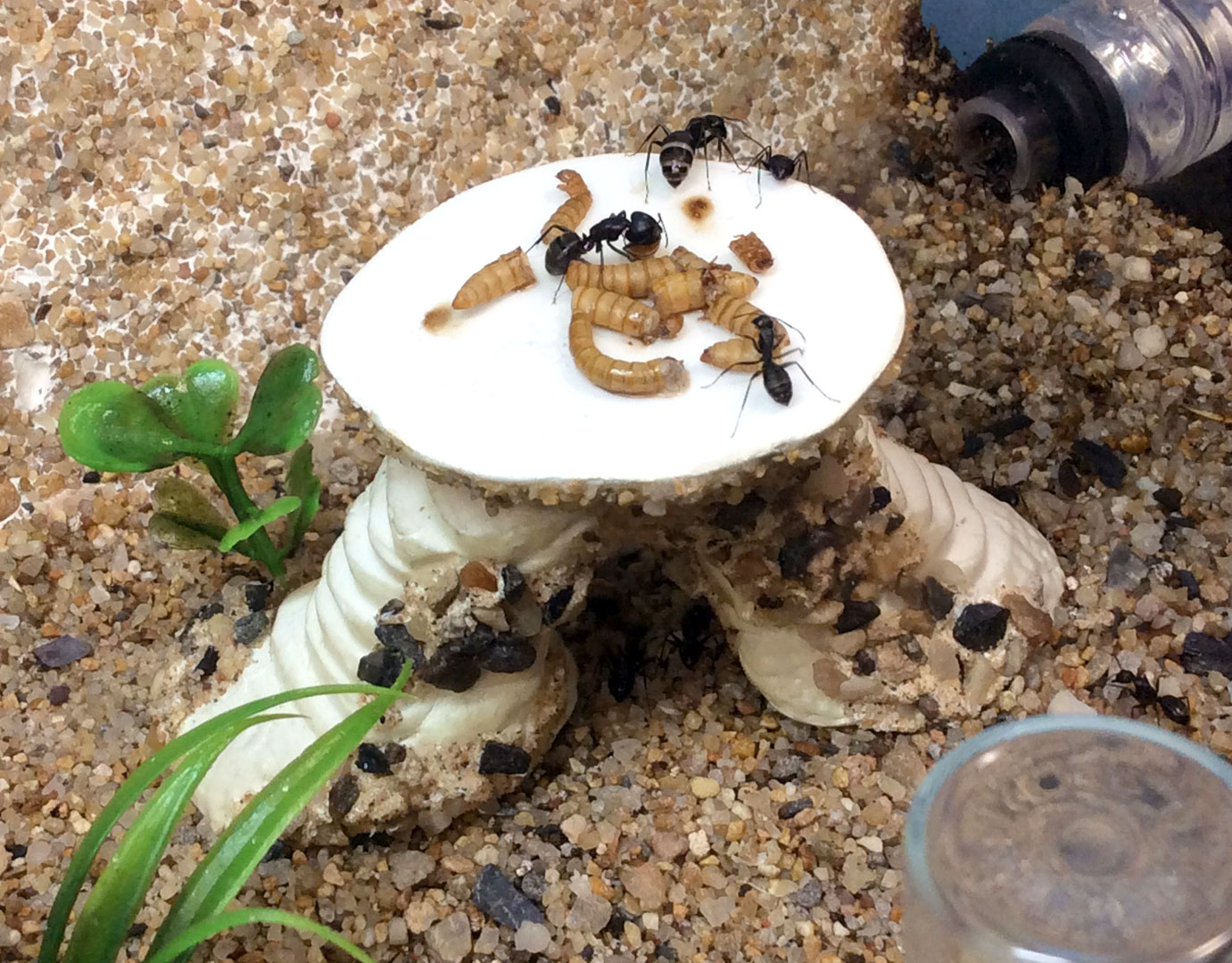






You’ve got to get comfortable with chopping up live feeders in order to feed your ant colonies properly so get used to moving bug parts.

Now my third staple feeder insect and quite possibly the most important one. I tried making my own fruit fly cultures this year and it went very well. I like using long slender tubes for the cultures as they worked well in keeping the populations low and made for easy handling.

Still pictures do not give justice to the activity in a fruit fly culture.
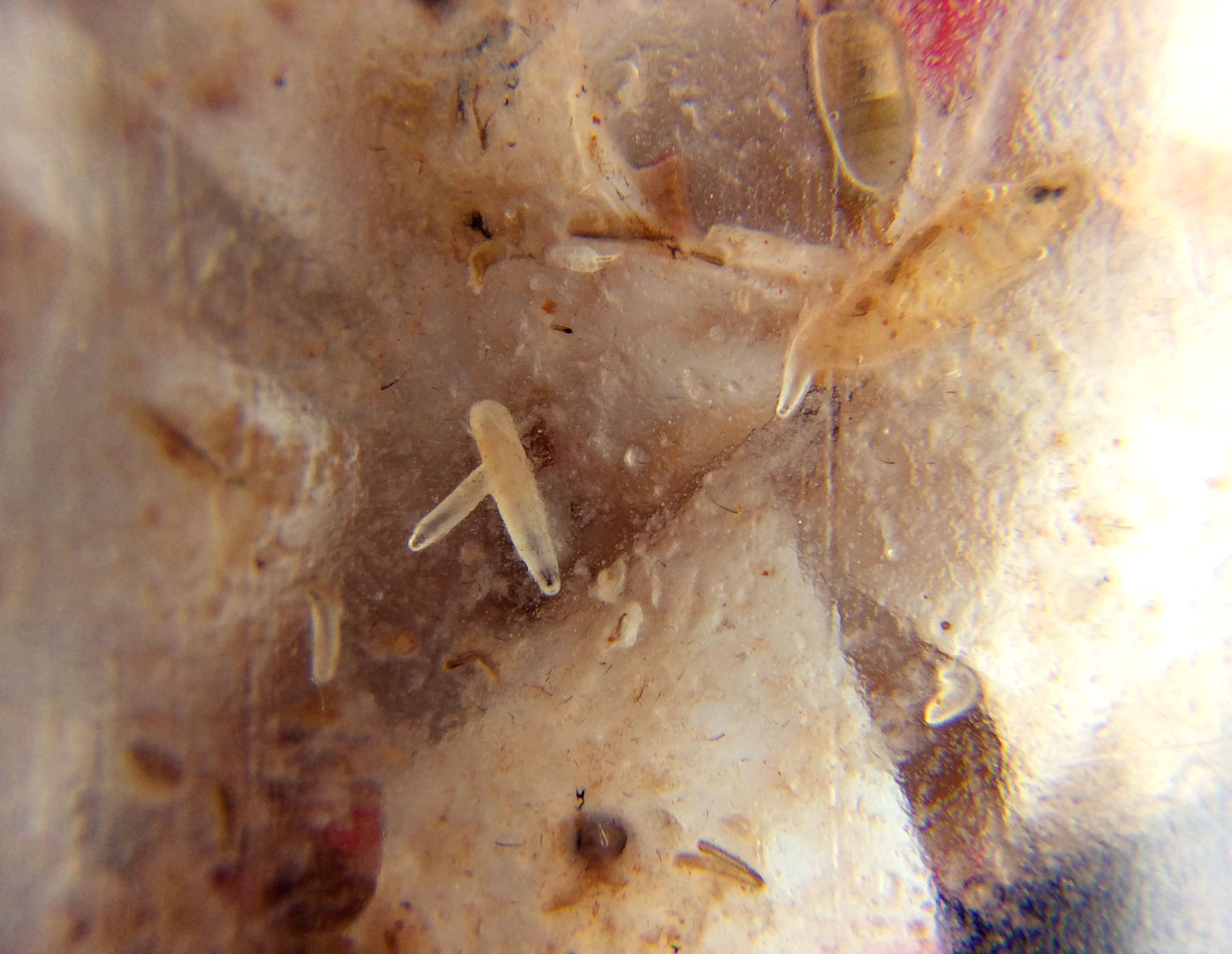
I got a little obsessive getting macro footage of my cultures, the grossness became beautiful to me. There’s just something mesmerizing in watching maggots feed that I couldn’t help getting too many extreme close up shots.



I want to share my recipe and culturing process in a future video, so I’ll be making more fruit fly content in the future.

As to why I say their important, I think that they provide more than just protein to our ants but possibly probiotics and beneficial microfauna that helps with keeping our colonies healthy in the long term. Carpenter ants have endosymbiotic microbes that need their own type of food. Fruit flies live in their own waste and the wastes of the microorganisms in the culture medium that it might provide some kind of needed nutrients for maintaining a larger ant colony through a nourished endosymbiotic system. That’s just my hypothesis on this matter and fruit flies may have no connection to this system.

I was initially using glass beakers and large test tubes for my fruit fly cultures but the thought of dropping a culture and letting loose hundreds of flies with shards of glass was too overwhelming for me that I switched to plastic. Here’s how easy the slender tubes were to feed to my ants, I’d just tip and tap the tube to get the fruit flies into the outworld. I was testing out different materials for the adult flies to use as surface area.

I was using sliced up plastic straws for the adult flies to crawl over in the beginning but found this paper packing that worked perfectly. I tried using some window screen at the bottom to separate the wet medium from soaking the paper packing.

After about a month of culturing, I’d have to reseed another tube then freeze the old one to kill off the culture. Then I’d have to use a skewer to clean out the plastic tube which I’d then wash and disinfect for the next batch. So I kept about 3-4 tubes going and then traded them off after a month, so i have 10 or so tubes in total to allow me to cycle through. They’re bead containers I found at the crafting/art store that works perfectly for ants because of how slim they are. Because these are the flightless variety, I don’t have any escapees feeding in this manner so it works well for me. It’s a feeding frenzy to watch ants go on the hunt and process their catch back in the nests.




The only issue with live fruit fly feeding is that they’ll leave poop on your outworld enclosures. With the amount of flies I was feeding, it’d sometimes take hours for my colony to hunt them all and that’d leave time for the flies to mingle about and crap everywhere. I just use a wet cotton ball and tongs to wipe away the built up waste when it became too much.
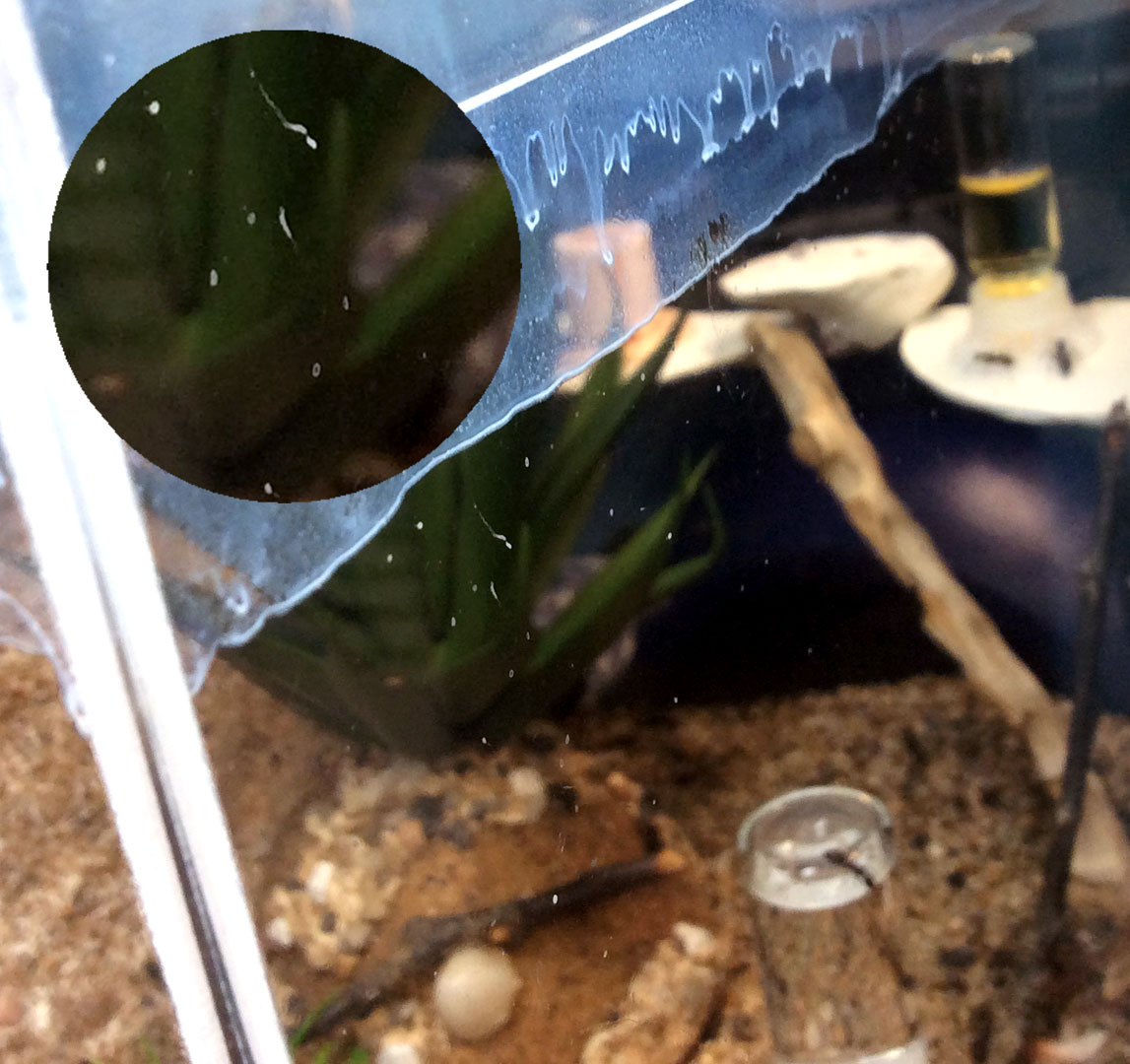
Turgid ant gasters late in the season is a sure sign your colony is well fed and prepping for diapause.
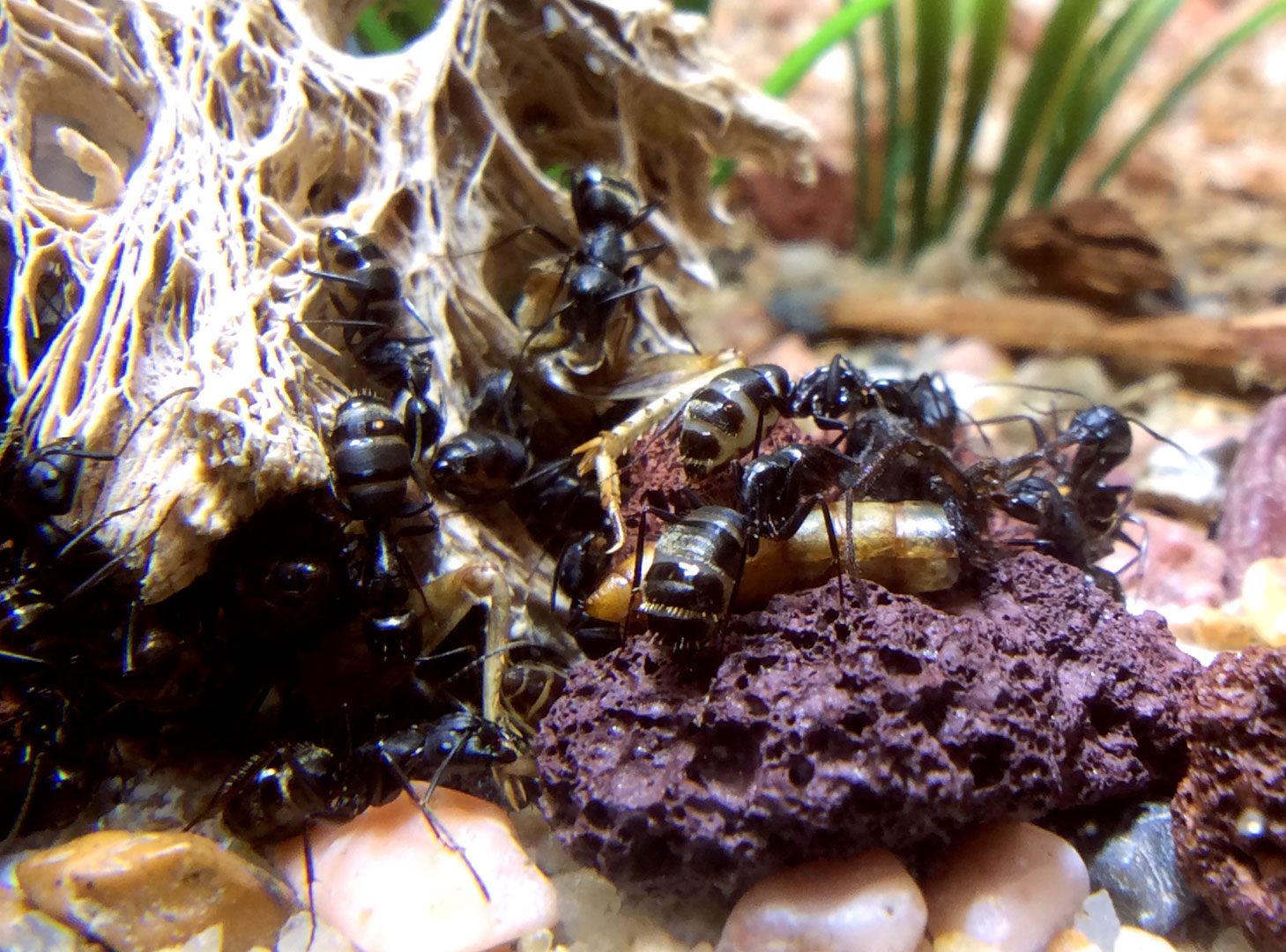
Now just a few words on liquid feeders. There should always be water in the outworld along with your liquid sugar changes. I’m a byFormica stan, their liquid feeders are the best and every antkeeper should try them out. I’ve gotten the variety packages and my Camponotus colony finally reached a population large enough for me to use the mega size for water.

I’ve been sticking to byFormica Sunburst Ant Nectar for my ants’ sugar intake lately and it’s been fine so far. I was feeding some fruit earlier in the year but decided against it after a die off from a piece of mango. I’ll stick to hard skinned fruits like melons in the future if I do decide to feed produce again.

Seeing gasters balloon up with liquid sugar is observational gold!

I hope this journal content is filling you right up!

I’ve also made this dog bowl style feeder that I use to feed random stuff or just to watch them lap up Sunburst Nectar in this manner.
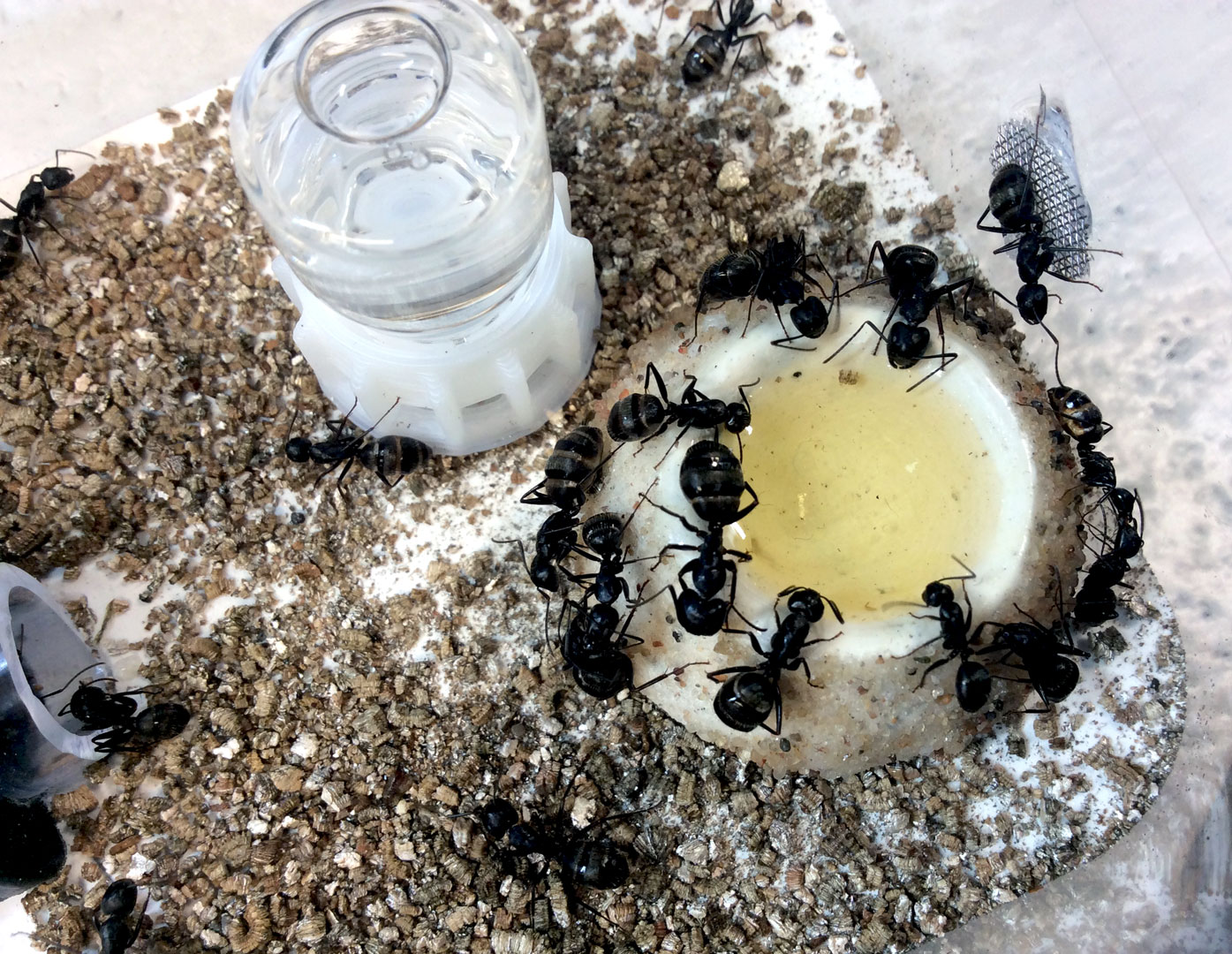
I also think that salt is a very important supplement to our ants and I add a pinch about once a month, using the bowl feeder above. The Sunburst Nectar has some in it but I like offering salt and sometimes solid sugar.
My three year old colony is doing well and I think that my feeding practices and variety is a part in making my colony a thriving one. You start to get to know a colony a little and I think you can tell when a colony is hungry. I didn’t have a hard schedule and amount of food that I followed, I just tried to observe how much they’d eat and would adjust accordingly.

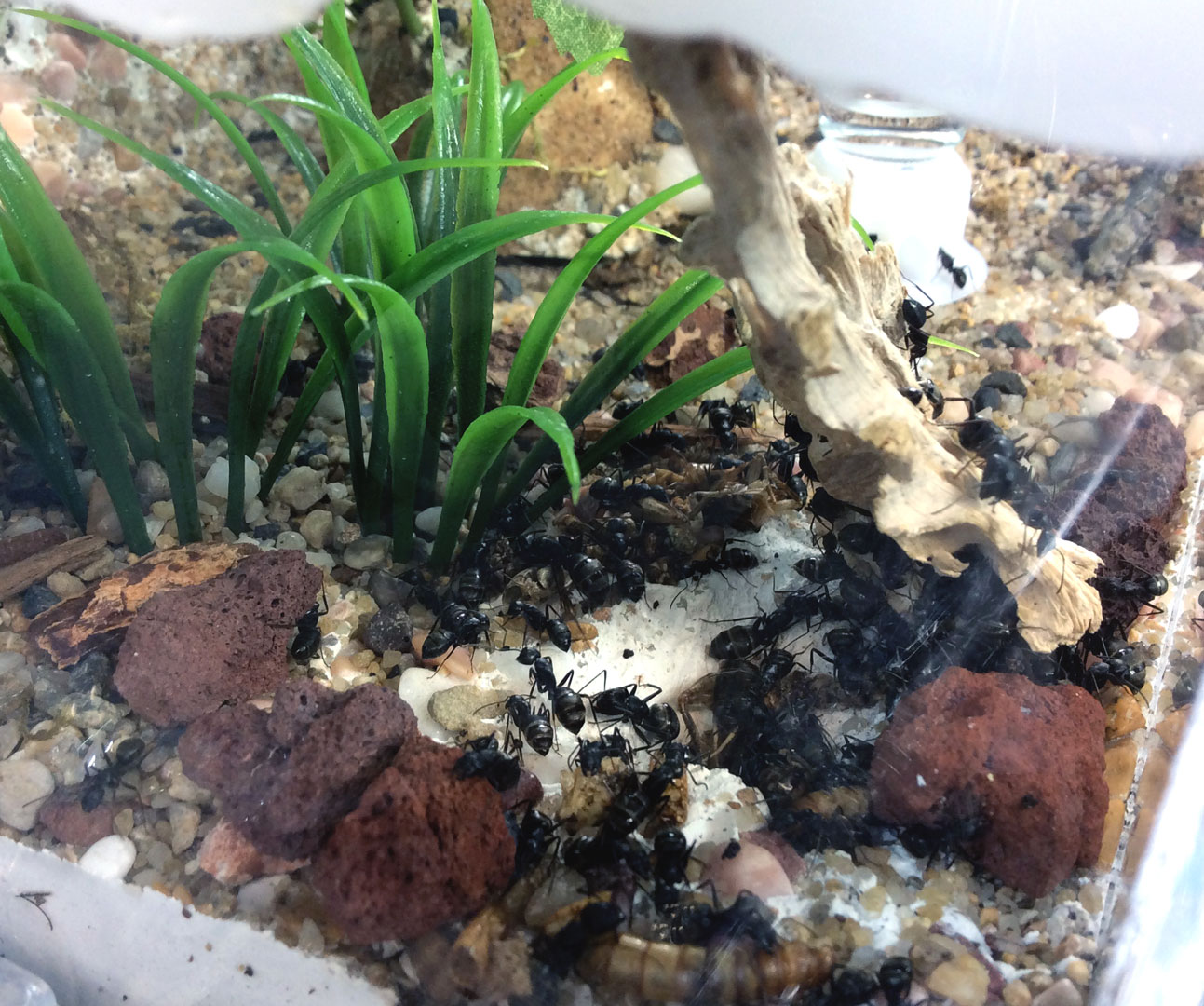


One of my ants was chilling out by the port where air pumps into the outworld from an aquarium pump. She was just hanging, relaxing with a cool breeze going through her antennae for a long time that I’m sure she had some micro naps in this position.

It reminded me of that old Maxwell logo from audio cassettes, haha!
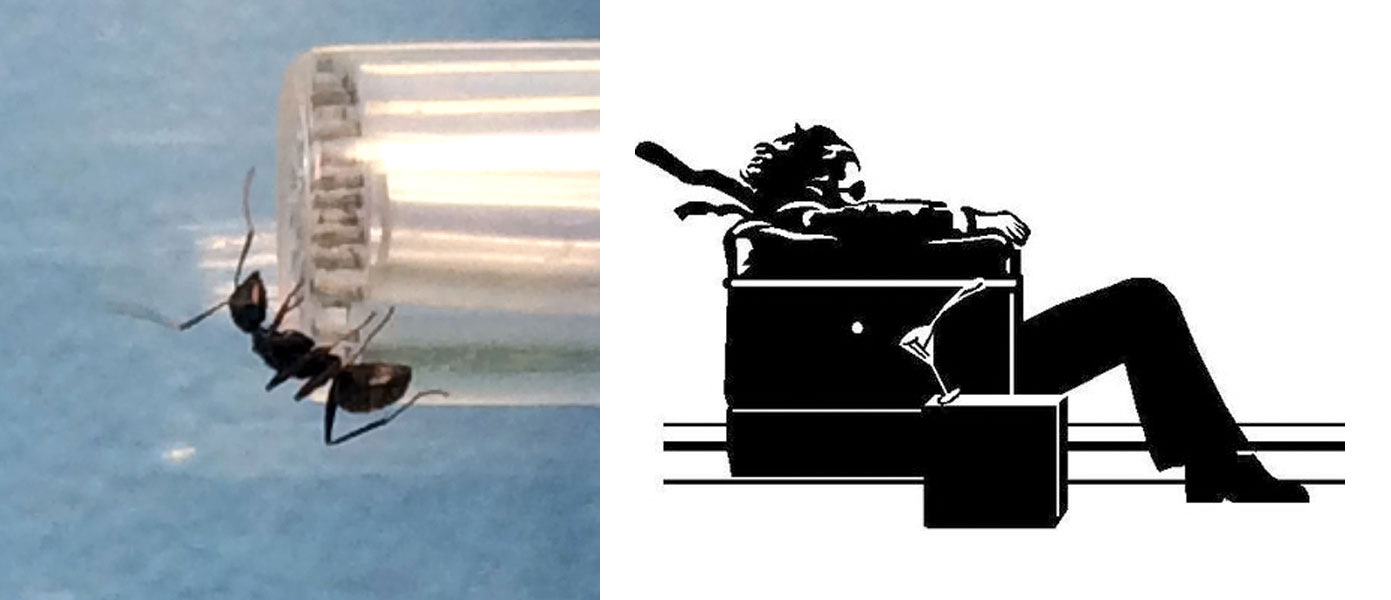
Of course all these feedings results in garbage piles in the outworld. Antkeepers should clean their enclosures often so as to not allow mites or mold to take hold. I use a keyboard vacuum on their midden piles which is weak enough to not harm the ants.

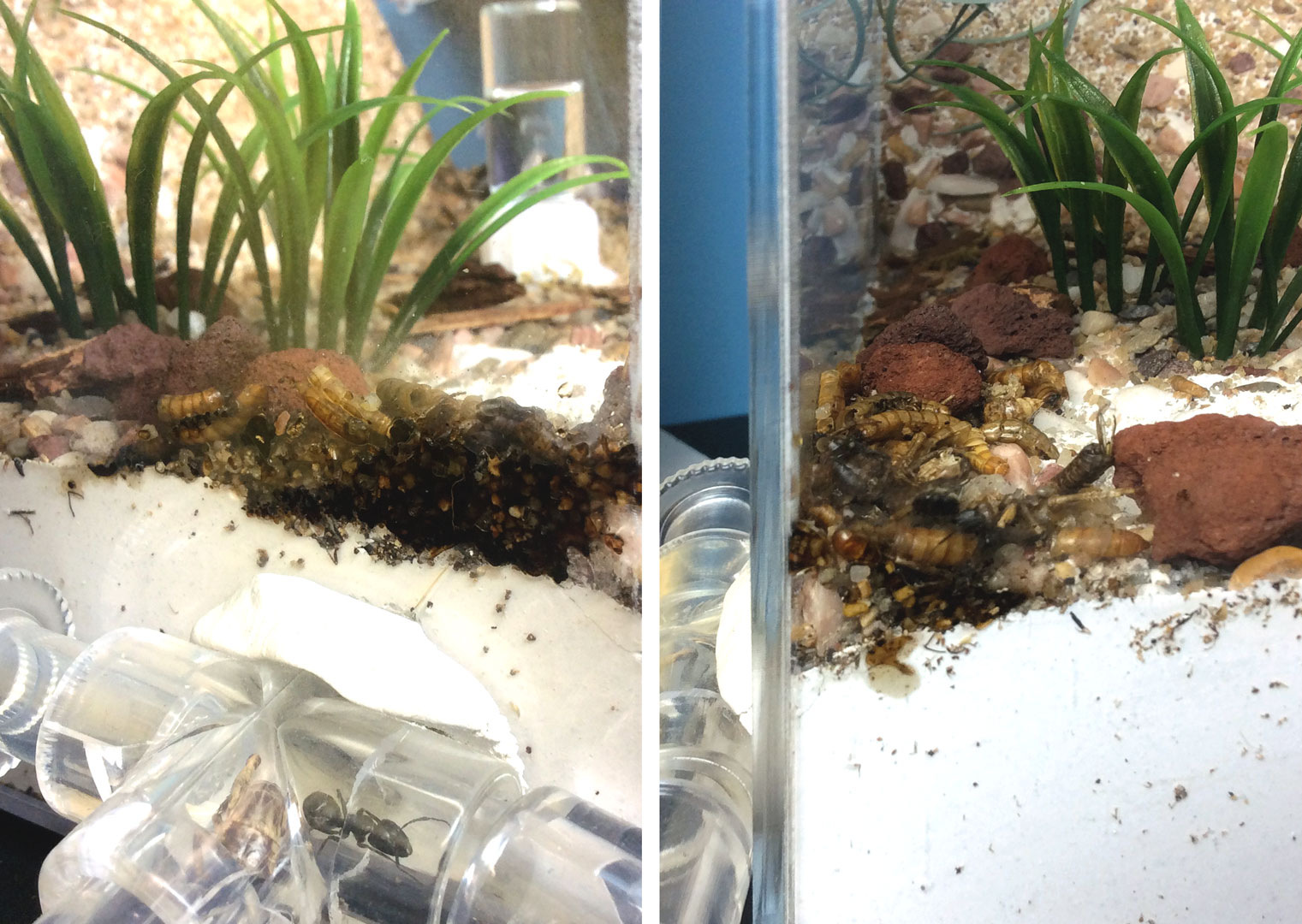
Here’s their outworld at the end of this ant season before I put them away for diapause. I couldn’t reach this side easily and they ended up using it for garbage and as a bathroom.

I’ll be showing more cleaning of the outworld in a future post but I do spend time washing it out before storing away during diapause. But it is important to maintain some cleanliness in their outworld while it’s in use.
The next post will focus on the colony’s growth and the nest expansion I added. After that one I want to focus on future Boog’s Bug Builds prototypes I’m testing out.
So that’s it for now, I hope this journal update was a good grooming!

